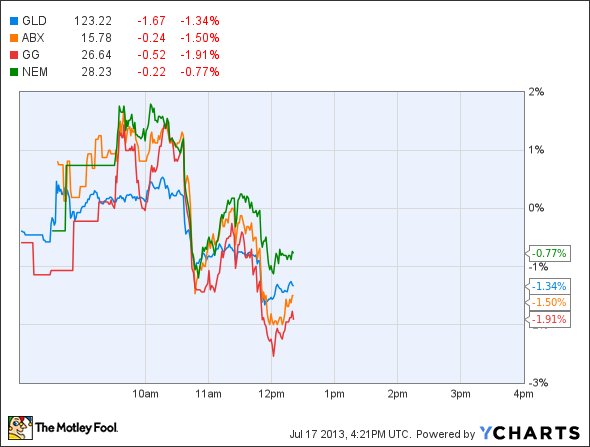In prepared remarks before the House Financial Services committee, Federal Reserve Chairman Ben Bernanke gave a typically noncommittal outlook for the Fed's action for the rest of the year. While the Chairman said the central bank planned to begin tapering the rate of quantitative easing later this year, he was quick to add that policy would remain accommodative and subject to change based on economic conditions. Gold, which had traded up mildly ahead of the news, fell sharply on the comments, but quickly recovered. The question now becomes, where does gold trade from here based on the expected Fed action?
Bernanke speaks Bernanke speak
When Bernanke gave his semiannual report to Congress, his remarks were expectedly, we'll do this, unless we don't and do that. In terms of the Fed's stance on monetary expansion, he said, "We anticipated that it would be appropriate to begin to moderate the monthly pace of purchases later this year." The last time Bernanke signaled that the Fed would slow the rate of bond buying, the market reacted poorly.
While the Chairman attempted to draw a distinction between tapering and accommodative policy, he qualified his position significantly: "With unemployment still high and declining only gradually, and with inflation running below the Committee's longer-run objective, a highly accommodative monetary policy will remain appropriate for the foreseeable future." Bernanke referred to the market's expectations on future rates as one of the key tools for keeping Fed policy accommodative, but emphasized that there is no predetermined path that is expected.
Gold reacts
Gold, as represented by the SPDR Gold Trust (GLD -0.99%), fell quickly on the remarks, but bounced back to unchanged in short order. The gold miners -- including Barrick (B -3.03%), Goldcorp (GG), and Newmont Mining (NEM -2.57%) had similar reactions (see chart). Looking ahead, the Fed is expecting U.S. GDP growth of 2.3% to 2.6% in 2013, accelerating to 3% to 3.5% in 2014. This growth is expected to come against a backdrop of falling unemployment, and an inflation rate in line with the targeted 2% rate set by the Fed.
Looking forward, if the U.S. economy is able to sustain the rates and growth expected by the central bank, the net effect is bearish for gold. As dollar-denominated assets become stronger and more attractive, the U.S. dollar will likely strengthen, as well. Gold is often seen as an alternative to dollar-denominated assets in times of weakness, so capital's ability to flow back to these assets may hurt gold.
The miners face a slightly different picture. While Barrick is still facing delays at Pascua-Lama, Goldcorp and Newmont have each seen solid production figures. The falling price of gold is the primary driver of these stocks, but economic stability could help the operational issues faced by the miners, as companies. Over the past several quarters, the miners have significantly underperformed the commodity; this trend could potentially begin to reverse.
Alternatively, there is a large contingent of investors -- of which I am one -- who believe that the equity markets have been over-supported by the Fed. At some point, when support is withdrawn, there will necessarily be a significant correction and, at that point, gold will look attractive. As Fools do not look to time the market, and as it will be very difficult to predict when such a correction is likely, you are likely better off waiting. Maintaining an allocation to gold is appropriate, but it is too soon to pile in, expecting prices to spike back to new highs.





